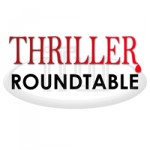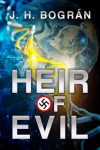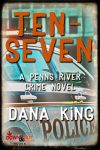

October 7 – 13: “Is it hard to start a new novel?”
 ITW members Elizabeth Goddard, James R. Hannibal, D. P. Lyle, Mark Atley, Marietta Miles, J. H. Bográn and Dana King are here this week to address the questions on everyone’s mind: Is it hard to start a new novel? Is there a difference between writing a series or stand-alone? Scroll down to the “comments” section to follow along. You won’t want to miss this!
ITW members Elizabeth Goddard, James R. Hannibal, D. P. Lyle, Mark Atley, Marietta Miles, J. H. Bográn and Dana King are here this week to address the questions on everyone’s mind: Is it hard to start a new novel? Is there a difference between writing a series or stand-alone? Scroll down to the “comments” section to follow along. You won’t want to miss this!
 Elizabeth Goddard is the bestselling author of more than forty books, including Never Let Go and the Carol Award-winning The Camera Never Lies. Her Mountain Cove series books have been finalists in the Daphne du Maurier Awards and the Carol Awards. Goddard is a seventh-generation Texan.
Elizabeth Goddard is the bestselling author of more than forty books, including Never Let Go and the Carol Award-winning The Camera Never Lies. Her Mountain Cove series books have been finalists in the Daphne du Maurier Awards and the Carol Awards. Goddard is a seventh-generation Texan.
 D. P. Lyle is the Amazon #1 Bestselling; Macavity and Benjamin Franklin Award-winning; and Edgar(2), Agatha, Anthony, Shamus, Scribe, Silver Falchion, and USA Today Best Book(2) Award-nominated author of 18 books, both fiction and non-fiction. He has worked with many novelists and with the writers of the TV shows Law & Order, CSI: Miami, Diagnosis Murder, Monk, Judging Amy, Cold Case, House, Medium, Women’s Murder Club, The Glades, and Pretty Little Liars.
D. P. Lyle is the Amazon #1 Bestselling; Macavity and Benjamin Franklin Award-winning; and Edgar(2), Agatha, Anthony, Shamus, Scribe, Silver Falchion, and USA Today Best Book(2) Award-nominated author of 18 books, both fiction and non-fiction. He has worked with many novelists and with the writers of the TV shows Law & Order, CSI: Miami, Diagnosis Murder, Monk, Judging Amy, Cold Case, House, Medium, Women’s Murder Club, The Glades, and Pretty Little Liars.
 As a former stealth pilot, James R. Hannibal is no stranger to secrets and adventure. He has been shot at, locked up with surface to air missiles, and chased by an armed terrorist. He is a two-time Silver Falchion award-winner for his children’s Section 13 mysteries and a Thriller Award nominee for his Nick Baron covert ops series. His first Clandestine Service thriller, the Grypyhon Heist, is out now from Revell.
As a former stealth pilot, James R. Hannibal is no stranger to secrets and adventure. He has been shot at, locked up with surface to air missiles, and chased by an armed terrorist. He is a two-time Silver Falchion award-winner for his children’s Section 13 mysteries and a Thriller Award nominee for his Nick Baron covert ops series. His first Clandestine Service thriller, the Grypyhon Heist, is out now from Revell.
 Black Rose Writing published Mark Atley’s debut novel, THE OLYMPIAN, at the end of June 2019. His short story “Amber Alert” won Honorable Mention in a local contest. Recently, Ink and Sword Magazine (Twitter) featured Mark in their December 2018 Crime Issue. Mark holds two degrees in journalism and works as a detective for a suburb of Tulsa, OK. He has overcome learning disabilities and struggled with dyslexia.
Black Rose Writing published Mark Atley’s debut novel, THE OLYMPIAN, at the end of June 2019. His short story “Amber Alert” won Honorable Mention in a local contest. Recently, Ink and Sword Magazine (Twitter) featured Mark in their December 2018 Crime Issue. Mark holds two degrees in journalism and works as a detective for a suburb of Tulsa, OK. He has overcome learning disabilities and struggled with dyslexia.
 Born in Alabama, raised in Louisiana, Marietta Miles currently resides in Virginia with her husband and two children. Her shorts and flash can be found in Thrills, Kills and Chaos, Flash Fiction Offensive, Yellow Mama, Hardboiled Wonderland, and Revolt Daily. Her stories have been included in anthologies available through Static Movement Publishing and Horrified Press. She is rotating host for Noir on the Radio, Dames in the Dark and a contributor to Do Some Damage Writer’s Blog.
Born in Alabama, raised in Louisiana, Marietta Miles currently resides in Virginia with her husband and two children. Her shorts and flash can be found in Thrills, Kills and Chaos, Flash Fiction Offensive, Yellow Mama, Hardboiled Wonderland, and Revolt Daily. Her stories have been included in anthologies available through Static Movement Publishing and Horrified Press. She is rotating host for Noir on the Radio, Dames in the Dark and a contributor to Do Some Damage Writer’s Blog.
 J. H. Bográn is an international author of novels, short stories and scripts for television and film. He’s the son of a journalist, but ironically prefers to write fiction rather than facts. His genre of choice is thrillers, but he likes to throw in a twist of romance into the mix. He currently divides his time as resource development manager for Habitat for Humanity Honduras, teaching classes at a local university, and writing his next project. He lives in San Pedro Sula, Honduras with his wife, three sons and a “Lucky” dog. His motto is “I never tell lies, I only write them!”
J. H. Bográn is an international author of novels, short stories and scripts for television and film. He’s the son of a journalist, but ironically prefers to write fiction rather than facts. His genre of choice is thrillers, but he likes to throw in a twist of romance into the mix. He currently divides his time as resource development manager for Habitat for Humanity Honduras, teaching classes at a local university, and writing his next project. He lives in San Pedro Sula, Honduras with his wife, three sons and a “Lucky” dog. His motto is “I never tell lies, I only write them!”
 Dana King’s Penns River series of police procedurals includes Worst Enemies, Grind Joint, and Resurrection Mall (all published by Down & Out Books). His Nick Forte series has two Shamus Award nominations, for A Small Sacrifice and The Man in the Window. The third book in the series, Bad Samaritan, was published by Down & Out Books in January 2018. His short fiction has appeared in Spinetingler, New Mystery Reader, A Twist of Noir, Mysterical-E, and Powder Burn Flash as well as the anthology Blood, Guts, and Whiskey, edited by Todd Robinson.
Dana King’s Penns River series of police procedurals includes Worst Enemies, Grind Joint, and Resurrection Mall (all published by Down & Out Books). His Nick Forte series has two Shamus Award nominations, for A Small Sacrifice and The Man in the Window. The third book in the series, Bad Samaritan, was published by Down & Out Books in January 2018. His short fiction has appeared in Spinetingler, New Mystery Reader, A Twist of Noir, Mysterical-E, and Powder Burn Flash as well as the anthology Blood, Guts, and Whiskey, edited by Todd Robinson.
- LAST GIRL MISSING with K.L. Murphy - July 25, 2024
- CHILD OF DUST with Yigal Zur - July 25, 2024
- THE RAVENWOOD CONSPIRACY with Michael Siverling - July 19, 2024
